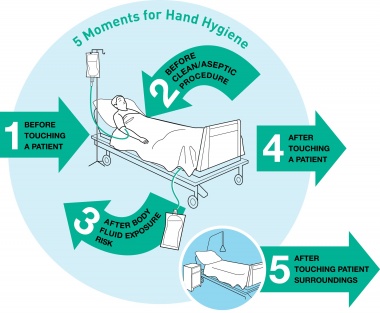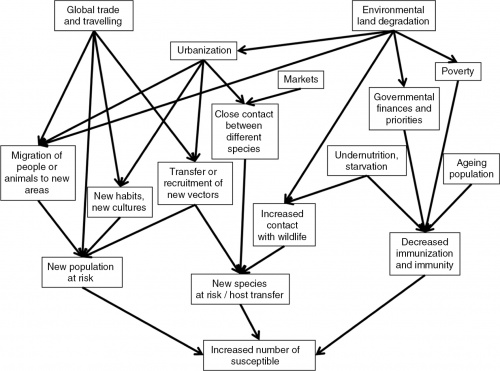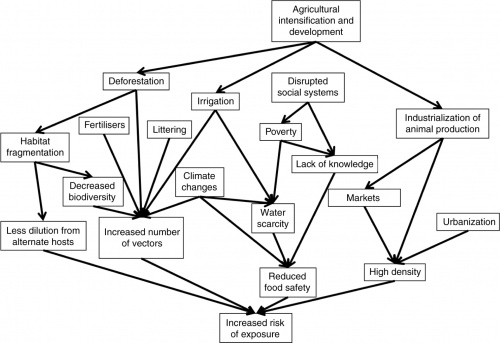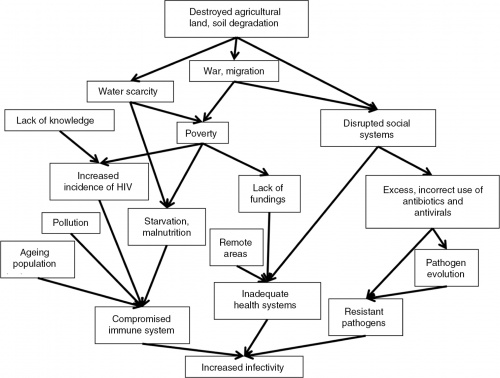Communicable Diseases
Original Editor - Your name will be added here if you created the original content for this page.
Top Contributors - Naomi O'Reilly, Lucinda hampton, Kim Jackson, Tony Lowe, Admin, Vidya Acharya, Jess Bell, Khloud Shreif, Olajumoke Ogunleye, Niha Mulla, 127.0.0.1, Laura Ritchie, Oyemi Sillo, Tarina van der Stockt and WikiSysop
Introduction[edit | edit source]
According to the World Health Organisation “over 13 million people die each year from Infectious and Parasitic Diseases: One in two deaths in some developing countries. Poor people, women, children, and the elderly are the most vulnerable. Infectious diseases continue to be the world’s leading killer of young adults and children” [1].
Socioeconomic, environmental and behavioural factors, as well as international travel and migration, foster and increase the spread of Communicable Diseases. Vaccine-preventable, foodborne, zoonotic, health care-related and communicable diseases pose significant threats to human health and may sometimes threaten international health security [2].
According to Lindahl and Grace (2015) communicable diseases have had civilisation-altering consequences throughout history. An estimated 50–100 million humans worldwide succumbed to infection during the Spanish Flu Pandemic in 1918–1920. While rinderpest was in part responsible for death by starvation of almost two-thirds of the East African Massai population after it caused massive death to livestock. [3]
As a result of better living conditions, increased access to health care including better vaccines, advent of antibiotics and improved surveillance and monitoring in relation to public health, the proportion of infectious diseases was tredning downwards during the early Twentieth Century, however, an increase in the emergence and re-emergence of infectious diseases became evident in many parts of the world towards teh later part of the Twentieth Century. [3] [4]
Weiss & McMichael (2015) hightlight that over 30 new, emerging diseases have been identified, including Legionnaires' Disease, Human Immunodeficiency Virus (HIV) / Acquired Immune Deficiency Syndrome (AIDS), Hepatitis C, Bovine Spongiform Encephalopathy (BSE) / Variant Creutzfeldt-Jakob Disease (vCJD), several Viral Hemorrhagic Fevers and, most recently, Severe Acute Respiratory Syndrome (SARS), Avian Influenza, Ebola and Zika Virus and in part relate the emergence of these diseases, and resurgence of old ones like Tuberculosis andCcholera to various changes in human ecology including rural-to-urban migration resulting in high-density peri-urban slums; increasing long-distance mobility and trade; the social disruption of war and conflict; changes in personal behavior; and, increasingly, human-induced global changes, including widespread forest clearance and climate change. [4]
What are Communicable Diseases[edit | edit source]
Communicable diseases are those that are spread from one person to another through a variety of methods. Socioeconomic, environmental and behavioural factors, as well as international travel and migration, foster and increase the spread of Communicable Diseases. Vaccine-preventable, foodborne, zoonotic, health care-related and communicable diseases pose significant threats to human health and may sometimes threaten international health security .How these diseases spread depends on the specific pathogen or infectious agent and means of transmission: [5]
Pathogens[edit | edit source]
Bacteria
- These one-cell organisms are responsible for illnesses such as strep throat, urinary tract infections and tuberculosis. Bacteria constitute approximately 38% of human pathogens, and 30% of the emerging pathogens in humans. [3] [6]
Viruses
- Even smaller than bacteria, viruses cause a multitude of diseases. According to Lindahl & Grace (2015) it is estimated that 44% of the diseases considered emerging in humans are viral. Emerging Infecttious Diseasese that that have received most publicity in the past 30 - 40 years have been viruses. Notable examples have been HIV, SARS, and Ebola. [3] [6]
Fungi
- Many skin diseases, such as ringworm and athlete's foot, are caused by fungi. Other types of fungi can infect your lungs or nervous system. [6] [3]
Parasites
- According to the CDC, a parasite is an organism that lives on or in a host and gets its food from or at the expense of its host. Malaria is caused by a tiny parasite that is transmitted by a mosquito bite. Other parasites may be transmitted to humans from animal feces. [6] [3] [7]
Prions
- A prion is an infectious agent composed entirely of protein material, called PrP (short for prion protein), that can fold in multiple, structurally distinct ways, at least one of which is transmissible to other prion proteins, leading to disease that is similar to viral infection. Bovine Spongiform Encephalopathy (BSE), also known as Mad Cow Disease, is a progressive neurological disorder of cattle that results from infection by an unusual transmissible agent called a prion. [3]
Transmission[edit | edit source]
Defining the means of transmission of a pathogen is important in understanding its biology and in addressing the disease it causes. Infectious organisms may be transmitted either by direct or indirect contact. Direct contact occurs when an individual comes into contact with the reservoir. Indirect contact occurs when the organism is able to withstand the harsh environment outside the host for long periods of time and still remains infective when specific opportunity arises.
Direct Contact
Person to Person:
- Physical Contact with an infected person, such as through Touch (e.g. Staphylococcus), Sexual Intercourse (e.g. Gonorrhea, HIV), Fecal/Oral Transmission (Hepatitis A), or Droplets (Influenza, Tuberculosis)
Animal to Person:
- Bites from infected insects or animals capable of transmitting disease (e.g. Mosquito: Malaria, Zika Virus and Yellow Fever; Flea: Plague; Tick: Lyme Disease); and handling of animal waste (e.g. Toxoplasmosis)
Mother to Unborn Child:
- Infecttious Disease may be trasmitted to the unborn child through the placenta or during passage through the vaginal canal during the birth process e.g. HIV, Hepatitis, Herpes, and Cytomegalovirus.
Indirect Contact
- Contact with a contaminated surface or object (Norovirus), Food (Salmonella, E. Coli), Blood (HIV, Hepatitis B), or Water (Cholera);
- Travel through the air (e.g. Tuberculosis or Measles)
Refresh your knowledge of some common communicable diseases:
Review your knowledge of Antibiotic Resistant Infectious Diseases which are frequent within the Hospital Setting
You can also check out our Infectious Disease Category which provides information on many other common and not so common Infectious Conditions:
Risk Factors[edit | edit source]
According to Boundless (2016) the spread and severity of infectious disease is influenced by many predisposing factors. Some of these are more general and apply to many infectious agents, while others are disease specific. Some predisposing factors of contracting infectious diseases can be anatomical, genetic, general and disease specific. Climate and weather, and other environmental factors that are affected by them, can also predispose people to infectious agents. Other factors such as overall health, age and diet are also important considerations in the prevention of spreading infectious diseases [8].
Modifiable Risk Factors [edit | edit source]
Refer to characteristics that individuals or societies can change to reduce risk of infectious disease and improve health outcomes. which include Hygiene including water and sanitation, Vaccinations, Malnutrition, Food Preparation Methods and Overcrowding.
Overcrowding [edit | edit source]
- High Population Density provides greater opportunity for contact between infectious diseases and susceptible people which leads to higher transmission rates.
- Large Concentration of Population once an epidemic starts, it spreads faster which leads to higher transmission rates.
- According to WHO from a purely epidemiological perspective, providing sufficient residential space and avoid of overcrowding provide high-impact public health interventions to reduce rate of transmission of communicable disease
Types of Diseases:
- Airborne Droplet Diseases e.g. Measles, Meningitis, Acute Respiratory Infections, and Tuberculosis.
- Faecal-Oral Diseases e.g. Diarrhoeal Diseases including Shigella and Cholera
Malnutrition[edit | edit source]
- Malnutrition leads to lower natural immunity, which often results in increased risk of infectious diesase and increased progression of disease. Nutritional Crises can Precipitate Epidemics as lower immunity often means lower vaccine efficacy, and therefore a higher susceptibility for transmission
- Globally, the severe malnutrition common in parts of the developing world causes a large increase in the risk of developing active tuberculosis and other opportunistic infections, due to its damaging effects on the immune system. Along with overcrowding, poor nutrition may contribute to the strong link observed between tuberculosis and poverty. [8]
Lindahl and Grace (2015) consider the factors that impact on the number of individuals susceptible to infection, the factors leading to increased exposure and the factors related increased risk of infectivity.
A new population can become at risk for an infection if a new pathogen is transferred to a previously uninfected area. This both can occur as a result of migration or travel over a distance where a pathogen is brought by an infected individual, in a vector, or in contaminated products, and it can be a slow progression into neighbouring areas, by animal, human, or vector movements. Cultural exchange may also cause a population to adopt new habits and acquire new risks. The framework showing factors contributing to increased susceptible populations is shown in Fig. 1.
|
Figure.1 Factors Leading to Increases in the Number of Susceptible Individuals [3] |
A major factor in the risk of exposure to a pathogen already in place is the pattern of interaction between individuals, which depends on the population density and behaviour. Increasing urbanization, as well as intensified animal keeping, increases exposure. A framework showing factors contributing to increased exposure is shown in Fig. 2.
|
Figure.2 Factors Leading to Increased Exposure to Infectious Diseases [3] |
How infectious an individual is following an infection, and for how long, is dependent on factors in the infected individual, on the pathogen, and the possibility of veterinary and medical care to cure the infection. A framework showing factors contributing to increased infectivity is shown in Fig. 3.
|
Figure.3 Factors Contributing to Increased Infectivity [3] |
Signs & Symptoms [edit | edit source]
Depending on the etiology (eg. virus, bacteria), the systems involved (e.g. respiratory, cardiovascular, central nervous system) and stage of disease (e.g. acute, chronic) the clinical manifestations of Communicable Diseases will vary widely and may be local to the site of infection (eg, cellulitis, abscess) or systemic (most often fever). Manifestations may also develop in multiple organ systems and severe, generalised infections may have life-threatening manifestations (eg, sepsis, septic shock). [9] [5]
Cardiovascular [edit | edit source]
- Tachycardia
- Bradycardia
- Hypotension
- Tachypnea
- Dyspnea
- Cough
- Hoarseness
- Sore Throat
- Nasal Drainage
- Sputum Production
- Oxygen Desaturation
- Decreased Activity/Exercise Tolerance
Central Nervous System [edit | edit source]
- Altered Conciousness
- Confusion
- Delirium
- Stupor
- Coma
- Seizure
- Headache
- Photophobia
- Memory Loss
- Stiff Neck
- Myalgia
Endocrinology
[edit | edit source]
- Increased Thyroid-stimulating Hormone
- Increased Vasopressin
- Increased Insulin
- Increased Glucagon
- Hyperglycemia
- Hypoglycemia
Gastrointestinal[edit | edit source]
- Nausea
- Vomitting
- Diarrhea
Geniturinary[edit | edit source]
- Heamaturia
- Dysuria
- Oliguria
- Proteinuria
- Urgency
- Frequency
Haematology[edit | edit source]
- Increased Immature Neutrophils
- Increased Mature Neutrophils
- Release Granulocytes
- Increased Leukocytes
- Thrombocytopenia
Integumentary[edit | edit source]
- Purulent Drainage
- Skin Rash
- Red Streaks
- Bleeding from Gums
- Bleeding into Joints
- Erythema
- Joint Effusions
Systemic[edit | edit source]
- Fever
- Chills
- Malaise
- Enlarged Lymph Nodes
- Changes in Mental Status
- Fatigue
- Lethargy
- Altered Appetite
Implications for Physiotherapy[edit | edit source]
As healthcare workers it is important that we recognise the symptoms of the most important infectious diseases and direct those affected to appropriate treatment as quickly as possible. It is also important to be aware of the role physiotherapy has in treating and advising patients presenting with these diseases (e.g. the benefits of exercise for patients with HIV/AIDS).
The statistics related to HealthCare Associated Infections make it clear Hand Hygiene in the healthcare environment is extremely important. As physiotherapists we need to learn how to use the alcohol hand rubs effectively and utilise these frequently. The WHO Guidelines identify 5 moments for Hand Hygiene:
- Before Touching the Patient Why? Protect the patient from acquiring germs that might be on your hands. Clean your hands prior to personal care activities like bathing, dressing, brushing and oral care, as well as non-invasive observations (taking vital signs) and treatments.
- Before Clean/Aseptic Procedure Why? Protect the patient from harmful germs, including their own, that could enter the body during procedures like needle insertions, medication administration and connecting to invasive medical devices like EEGs.
- After Body Fluid Exposure Risk Why? Protect yourself and the patient’s surroundings from harmful patient germs generated via contact with fluids like blood, saliva, mucous, semen, tears or urine.
- After Touching a Patient Why? Protect yourself and the immediate environment from harmful patient germs. After you touch a patient, you could have microorganisms on your hands that would get passed on to other patients.
- After Touching Patient Surroundings Why? Protect yourself and the immediate surroundings from harmful patient germs.
 [10] [10]
|
[11] |
Resources[edit | edit source]
Recent Related Research (from Pubmed)[edit | edit source]
Extension:RSS -- Error: Not a valid URL: Feed goes here!!|charset=UTF-8|short|max=10
References[edit | edit source]
- ↑ World Health Organization. Communicable Disease Prevention, Control and Eradication. http://www.who.int/countries/eth/areas/cds/en/ (accessed 21 Dec 2016)
- ↑ World Health Organization. Infectious Diseases. http://www.who.int/topics/infectious_diseases/en/ (accessed 21 Dec 2016)
- ↑ 3.0 3.1 3.2 3.3 3.4 3.5 3.6 3.7 3.8 3.9 Lindahl JF, Grace D. The consequences of human actions on risks for infectious diseases: a review. Infection ecology & epidemiology. 2015;5. Available at: http://www.infectionecologyandepidemiology.net/index.php/iee/article/view/30048
- ↑ 4.0 4.1 Weiss RA, McMichael AJ. REPRINT H. Health of People, Places and Planet: Reflections based on Tony McMichael’s four decades of contribution to epidemiological understanding. 2015 Jul 31;10(12):431.
- ↑ 5.0 5.1 Goodman CC, Fuller KS. Pathology: implications for the physical therapist. Elsevier Health Sciences; 2014 Nov 5.
- ↑ 6.0 6.1 6.2 6.3 Mayo Clinic. Infectious Diseases. http://www.mayoclinic.org/diseases-conditions/infectious-diseases/symptoms-causes/dxc-20168651 (accessed 19 Dec 2016).
- ↑ Centre for Disease Control. Parasites. https://www.cdc.gov/parasites/ {Accessed: 11 Dec 2016)
- ↑ 8.0 8.1 Boundless. “Predisposing Factors.” Boundless Microbiology Boundless, 08 Aug. 2016. Retrieved 12 Jan. 2017 from https://www.boundless.com/microbiology/textbooks/boundless-microbiology-textbook/epidemiology-10/disease-patterns-132/predisposing-factors-674-10797/
- ↑ Merck Manual Professional Version. Manifestations of Infection. http://www.merckmanuals.com/professional/infectious-diseases/biology-of-infectious-disease/manifestations-of-infection (accessed 16 Dec 2016)
- ↑ DebMed. 5 Moments vs. 2 Moments. What is enough when it comes to Hand Hygiene?. http://blog.debmed.com/blog/5-moments-vs.-2-moments.-what-is-enough-when-it-comes-to-hand-hygiene (accessed 2 Dec 2016).
- ↑ Huang Shouyung. WHO Hand Hygiene Video https://youtu.be/s08yiZBSGOw (accessed 2 Dec 2016).









